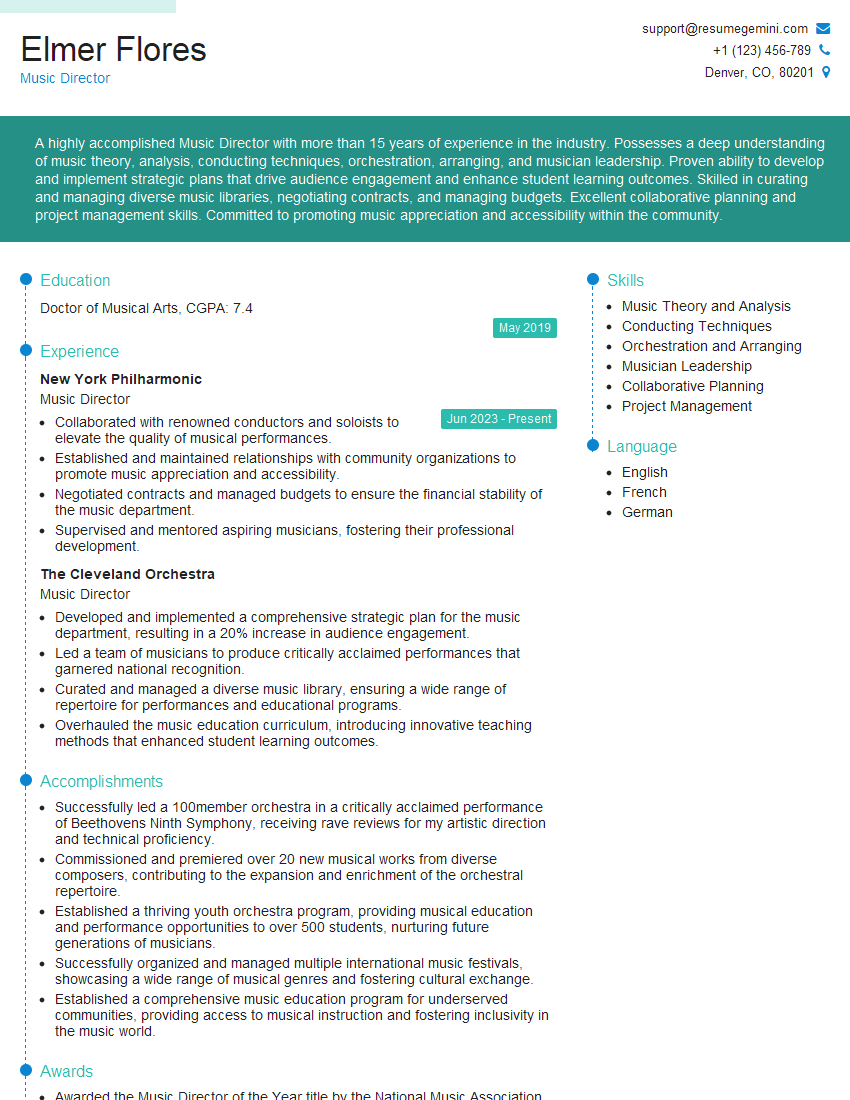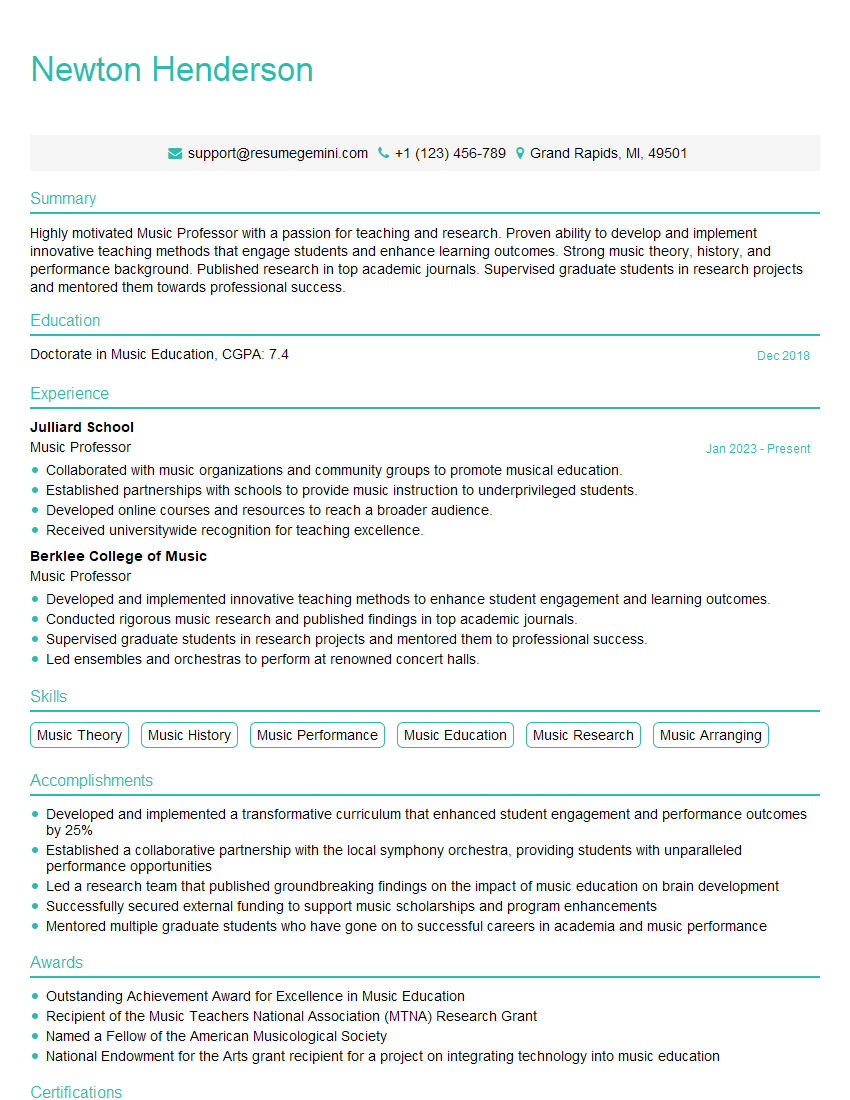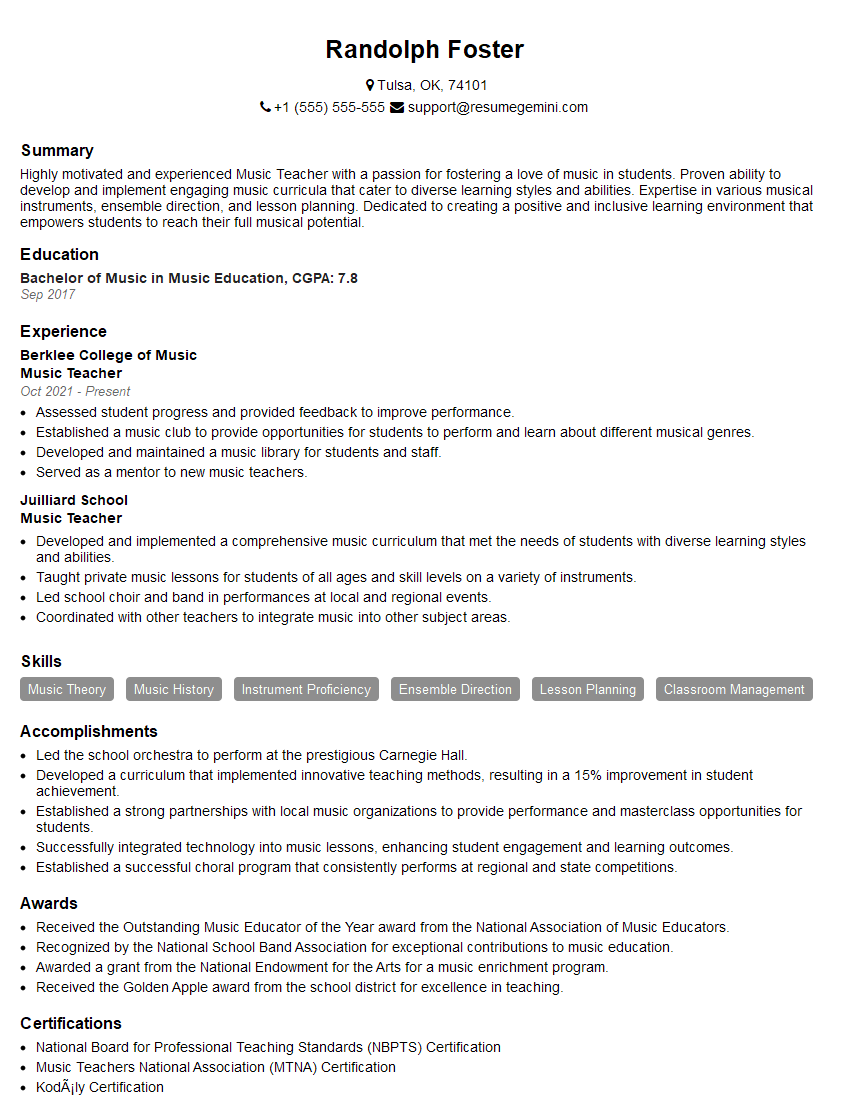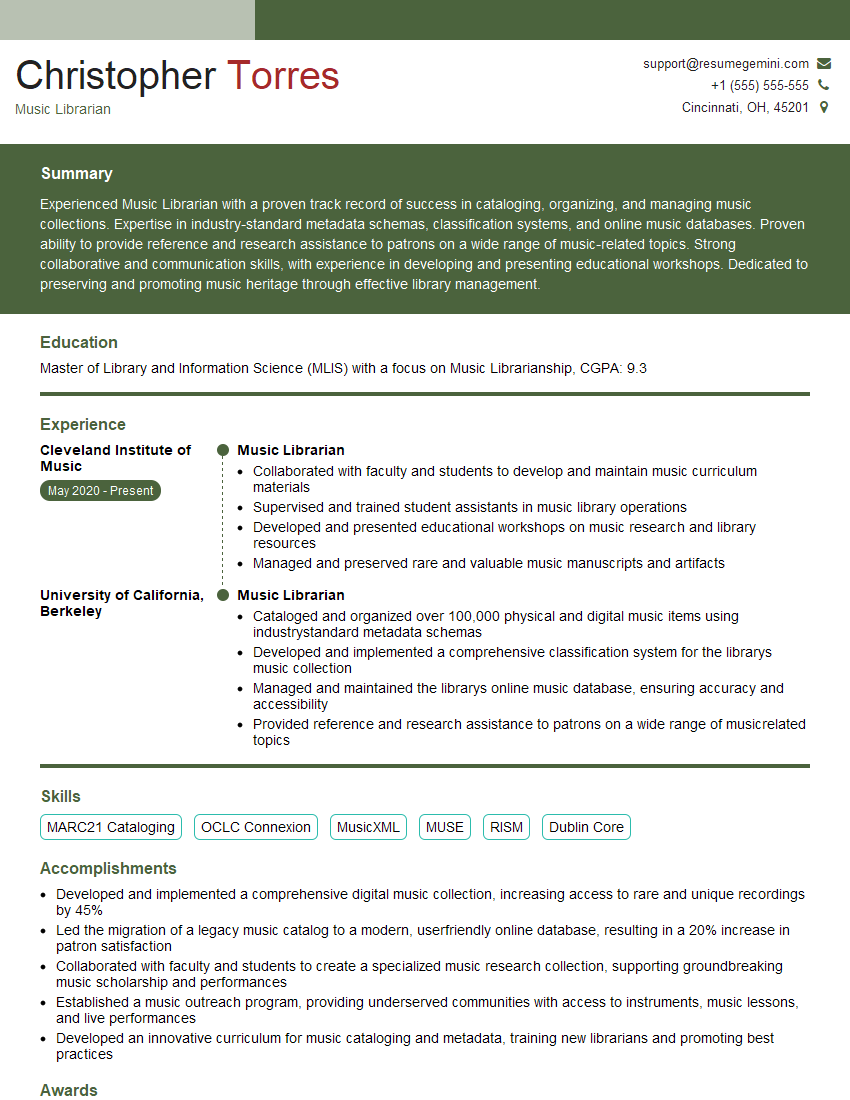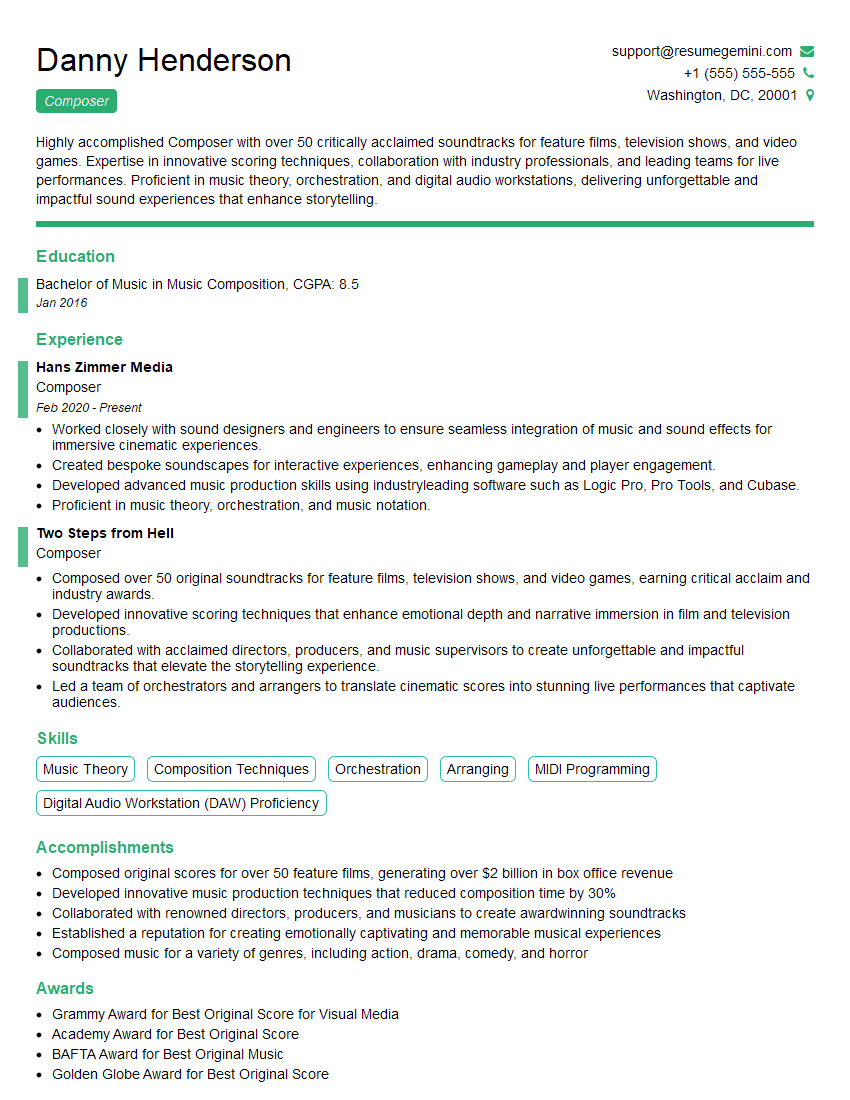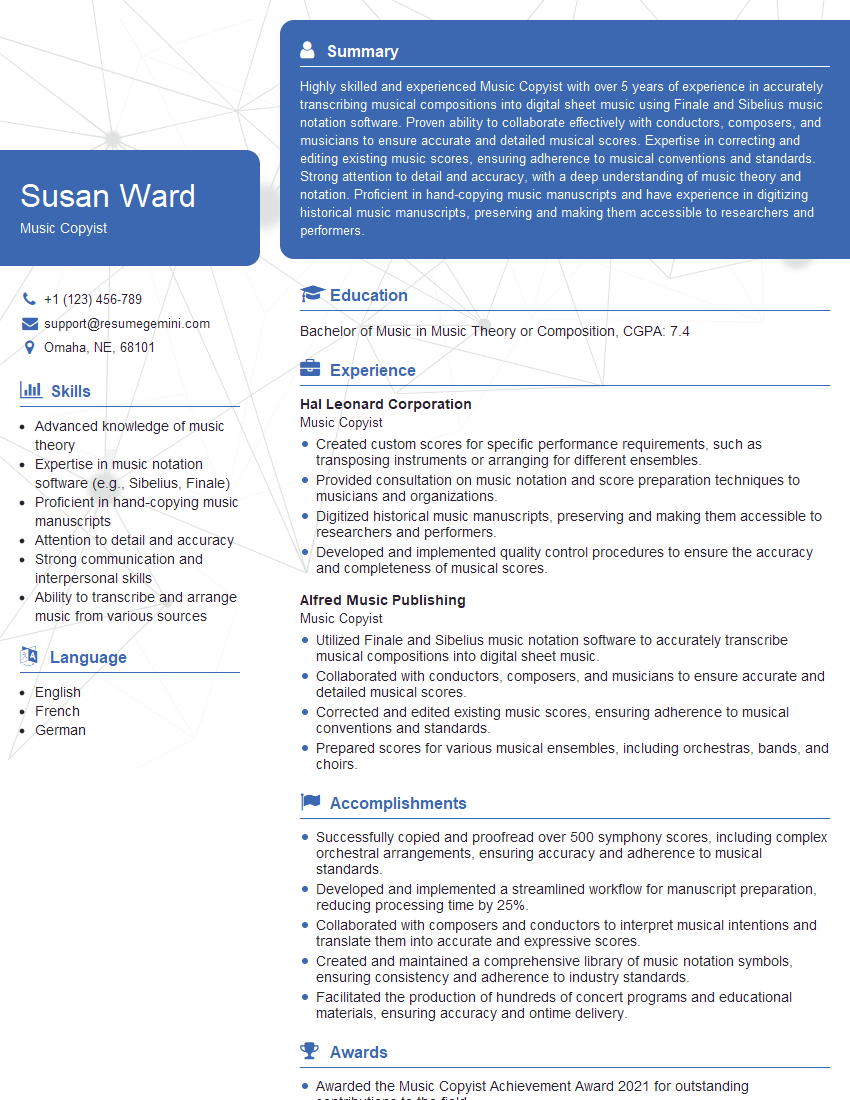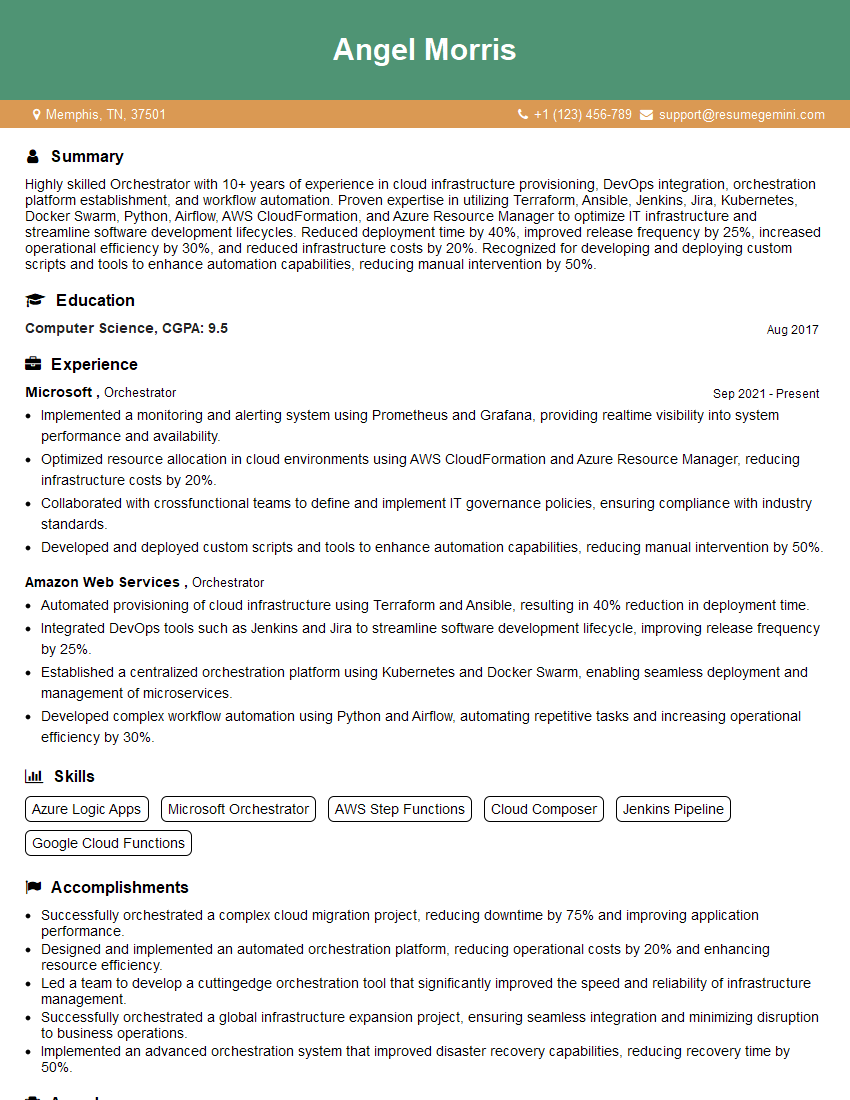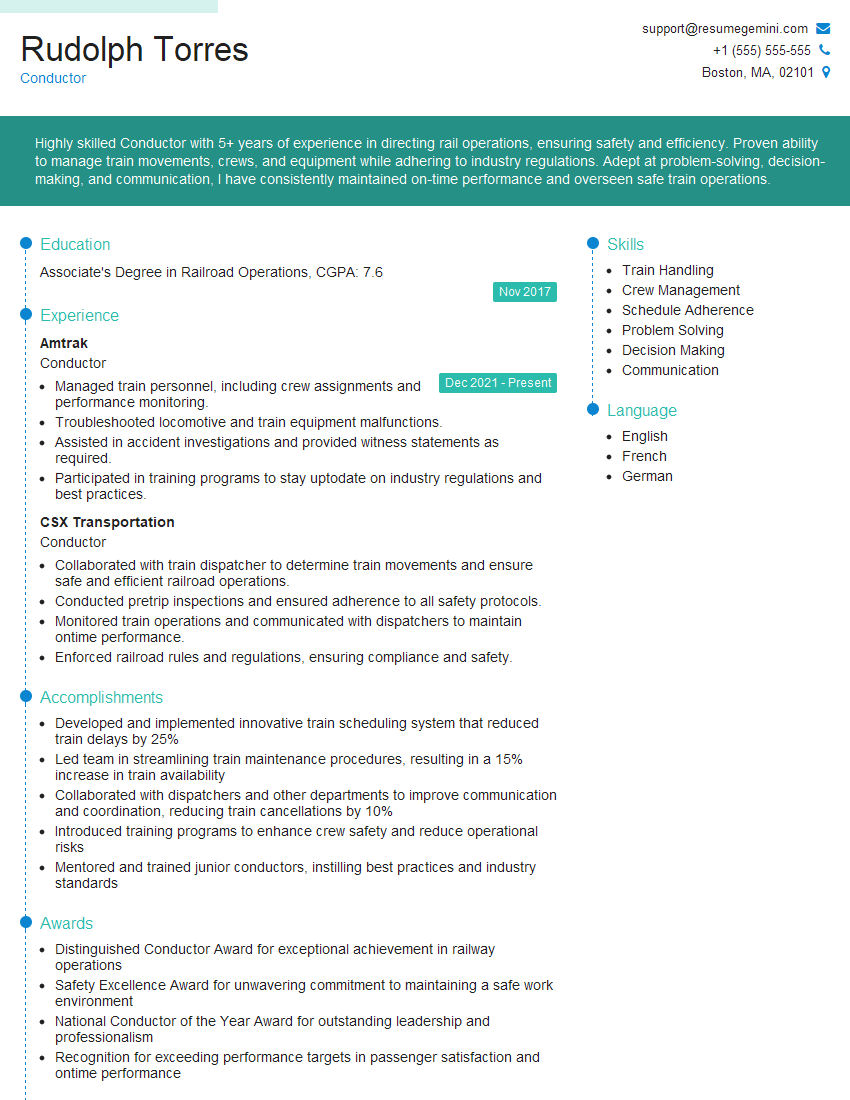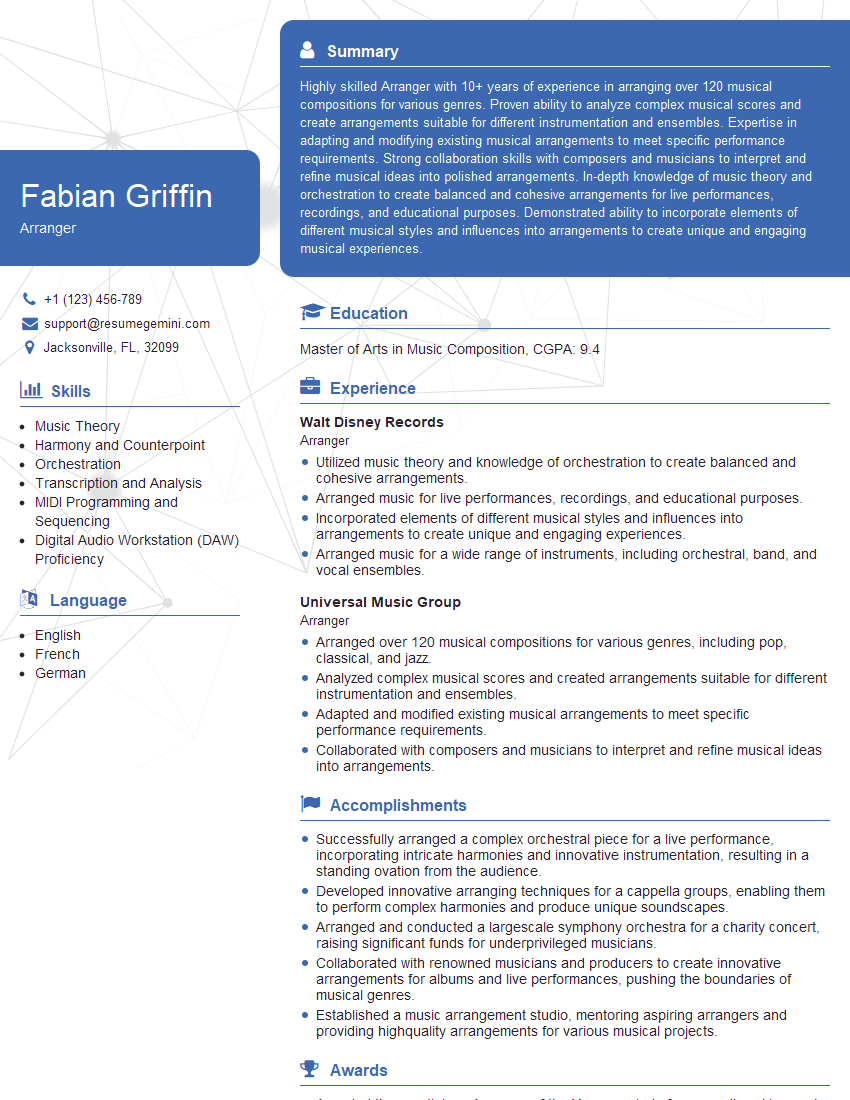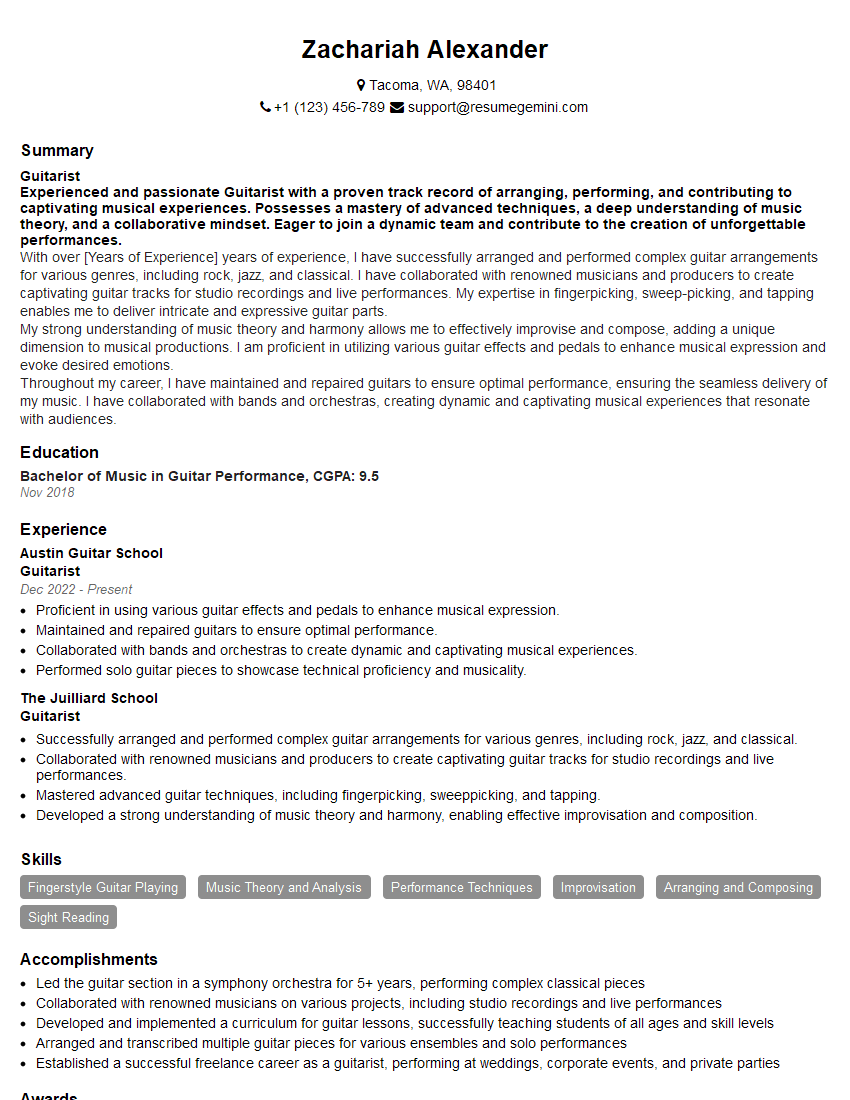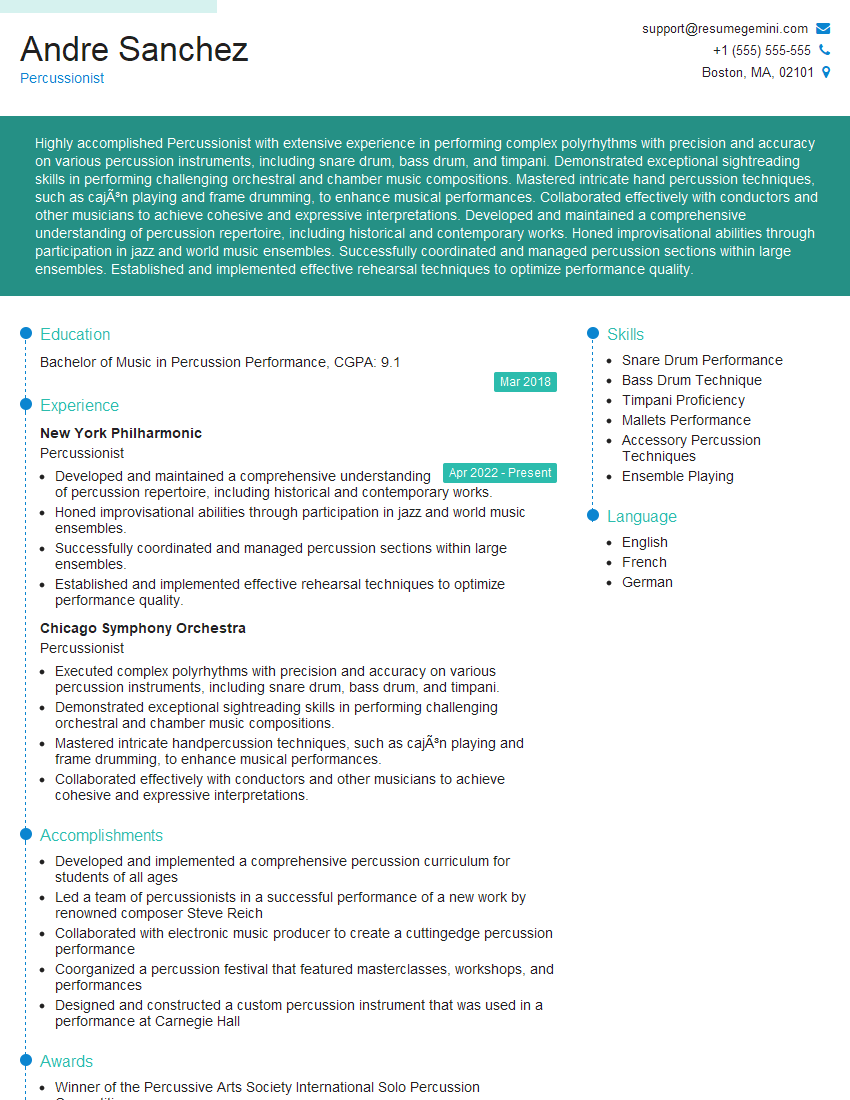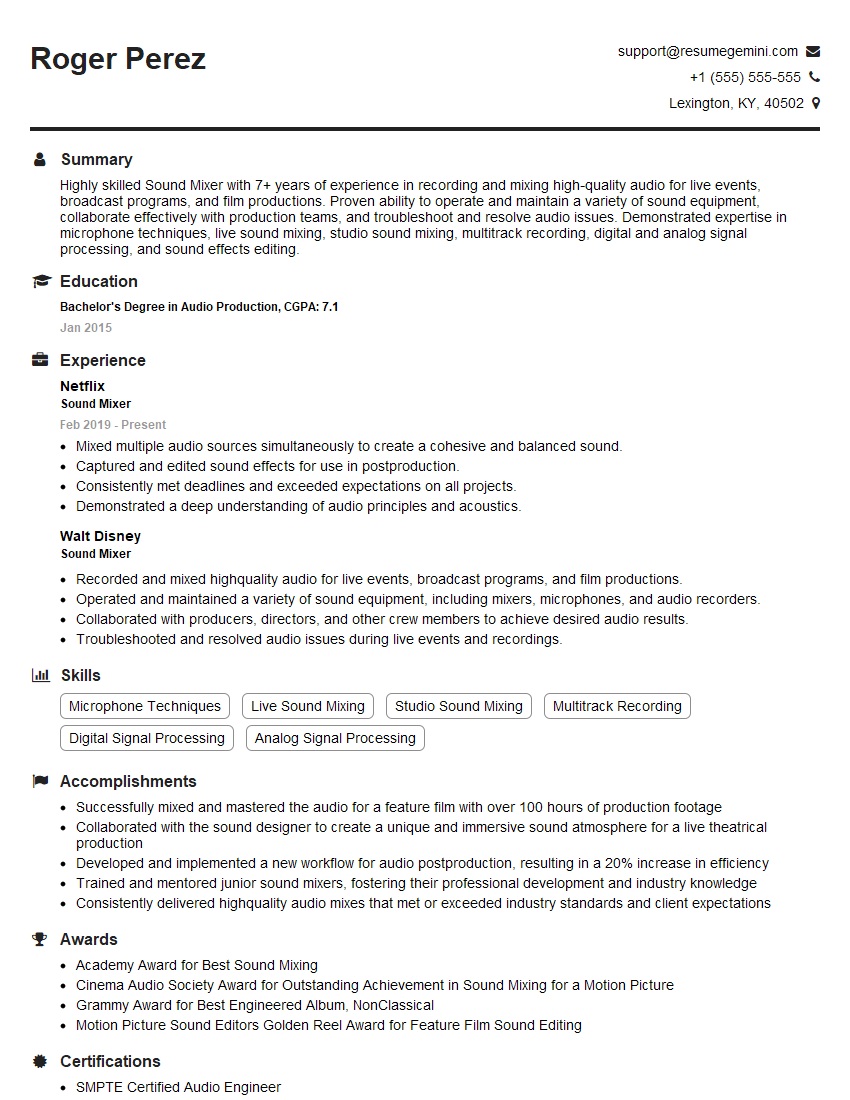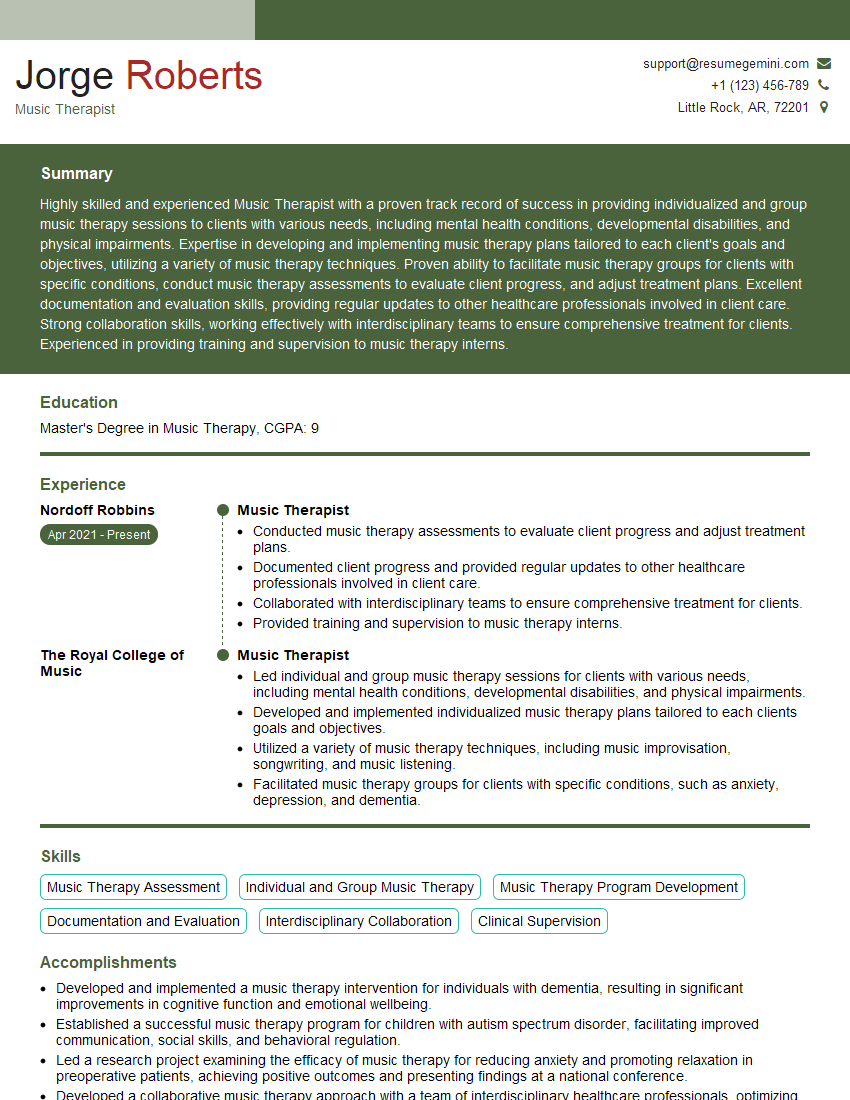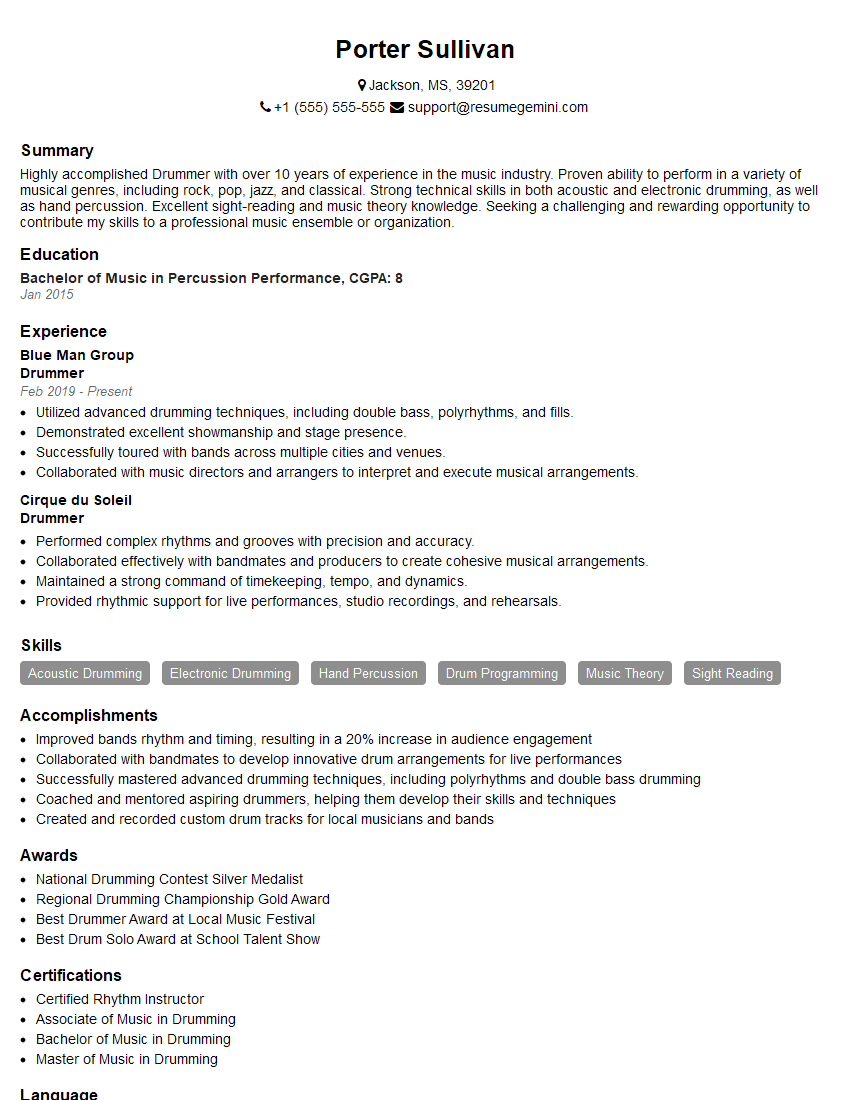Interviews are more than just a Q&A session—they’re a chance to prove your worth. This blog dives into essential Musicality and Rhythm interview questions and expert tips to help you align your answers with what hiring managers are looking for. Start preparing to shine!
Questions Asked in Musicality and Rhythm Interview
Q 1. Define syncopation and provide a musical example.
Syncopation is a rhythmic device where the emphasis falls on a weak beat or an offbeat, creating a sense of surprise or rhythmic interest. Think of it as a playful disruption of the expected rhythm. It’s like unexpectedly stepping to the side while everyone else is marching forward in a parade.
A simple example is the classic ‘surprise’ rhythm often used in pop and jazz music. Imagine a basic four-beat measure in 4/4 time. Normally, the emphasis is on beats 1 and 3. Syncopation would involve emphasizing beats 2 and 4, or even placing the emphasis between beats.
Musical Example: Let’s represent a simple rhythm using numbers where the higher number indicates a stronger emphasis. A typical 4/4 beat might be represented as 1 2 3 4. A syncopated version could be 2 4 or even something like 1 & 3 &, where the ‘&’ represents the offbeats between the main beats.
Q 2. Explain the difference between simple and compound time signatures.
Simple and compound time signatures differ in how they divide the beat. Simple time signatures have beats that are subdivided into two equal parts (usually with notes like quarter notes and eighth notes), while compound time signatures divide the beat into three equal parts (often using dotted notes and sixteenth notes).
Simple Time: Think of a simple, steady march. 4/4 time (four quarter notes per measure) is an example. Each beat is easily subdivided into two. 3/4 time (waltz) is another, with each beat subdivided into two.
Compound Time: Imagine a slightly more complex, flowing rhythm. 6/8 time is a common compound time signature. Each beat is actually divided into three, making it feel more like two beats with triplets. Other examples include 9/8 and 12/8.
In essence, the numerator of the time signature in simple meters always divides into two (or a power of two), reflecting the binary nature of the beat subdivisions. In compound meters, the numerator is always a multiple of three, representing the ternary subdivision.
Q 3. Describe the various rhythmic subdivisions of a beat.
The rhythmic subdivisions of a beat depend heavily on the time signature and the musical style. Common subdivisions include:
- Half note: Two half notes make up a whole note.
- Quarter note: Four quarter notes make up a whole note.
- Eighth note: Eight eighth notes make up a whole note.
- Sixteenth note: Sixteen sixteenth notes make up a whole note.
- Thirty-second note: Thirty-two thirty-second notes make up a whole note.
- Triplets: Three notes played in the time of two.
These subdivisions allow for a wide range of rhythmic complexity and nuances within a piece of music. Think of a drummer creating intricate fills – these are built using various subdivisions of the beat.
Q 4. How do you identify a musical phrase?
Identifying a musical phrase is like identifying a sentence in a piece of writing. A phrase is a complete musical thought – a short melodic or rhythmic idea that feels self-contained. They usually have a sense of beginning, middle, and end.
Several factors help identify a musical phrase:
- Melody: Phrases often have a clear melodic contour, rising and falling in pitch.
- Rhythm: Phrases often have a distinct rhythmic shape or pattern.
- Cadence: Musical phrases often end with a cadence—a resting point that provides a sense of closure.
- Dynamics: A change in volume can sometimes signal the beginning or end of a phrase.
- Instrumentation: Changes in instrumentation might denote a phrase’s beginning or end.
Think of a song’s verse or chorus – these are usually made up of several musical phrases. Listening for these natural breaks and melodic shapes helps define the structure of a piece.
Q 5. Explain the concept of rhythmic displacement.
Rhythmic displacement involves shifting a rhythmic pattern slightly forward or backward in time. It’s like taking a step out of line in a dance sequence, creating a rhythmic surprise. This technique creates rhythmic tension and interest, making the music more dynamic and unpredictable.
For example, imagine a simple repeated rhythmic pattern. Displacing it would involve shifting some notes slightly earlier or later, altering the timing but maintaining the overall rhythmic character. This can be subtly done by adding or subtracting rests at specific points. This is often used in jazz and other improvisational music styles, creating a syncopated and engaging groove.
Q 6. What are the different types of rhythmic patterns?
There’s a vast variety of rhythmic patterns. Here are a few categories:
- Simple rhythmic patterns: These are straightforward patterns, often using basic note values like quarter notes and eighth notes.
- Complex rhythmic patterns: These patterns use a wider range of note values, including dotted notes, triplets, and rests, creating more intricate and irregular rhythms.
- Syncopated rhythmic patterns: As discussed earlier, these emphasize offbeats, creating a rhythmic tension.
- Polyrhythmic patterns: These involve two or more independent rhythmic patterns occurring simultaneously. Think of the interplay between the drummer and bassist in many musical genres.
- Ostinato patterns: A short rhythmic or melodic figure repeated persistently throughout a piece.
The specific types of rhythmic patterns used in a piece of music greatly impact its character and style.
Q 7. How does rhythm contribute to the overall mood and emotion of a piece?
Rhythm is a fundamental element that significantly shapes the mood and emotion of a musical piece. Think of it as the heartbeat of the music. A fast, driving rhythm usually conveys energy and excitement, while a slow, steady rhythm can create a sense of calmness or solemnity.
For instance:
- Fast tempos and complex rhythms: Often evoke feelings of excitement, urgency, or even chaos.
- Slow tempos and simple rhythms: Typically create a sense of calmness, peacefulness, or melancholy.
- Syncopation: Can add a sense of surprise, tension, or excitement.
- Polyrhythms: Can create a feeling of complexity, intensity, or even spiritual transcendence.
Composers meticulously craft the rhythmic structure of their pieces to evoke the desired emotional responses in the listener. The rhythmic choices are directly linked to the overall emotional arc and narrative of the music.
Q 8. Describe how tempo affects the feeling of a musical piece.
Tempo, or the speed of the music, profoundly impacts the emotional feel of a piece. Think of it like the pace of a story – a slow tempo (adagio) can create a sense of solemnity, introspection, or even suspense, while a fast tempo (allegro) might evoke excitement, energy, or even frenzy. The tempo directly affects the listener’s perception of time and, consequently, their emotional response.
For example, a melancholic melody played at a slow tempo will feel much more sorrowful than the same melody played quickly. Conversely, a lively tune played slowly might sound ponderous or even comical, altering its intended effect. Composers carefully choose tempos to enhance the narrative arc and emotional impact of their work, creating specific moods and shaping the listener’s experience.
Q 9. How would you analyze the rhythmic complexity of a given score?
Analyzing rhythmic complexity involves examining several factors. First, consider the meter – the underlying pulse and grouping of beats (e.g., 4/4, 6/8, 3/4). Then, analyze the rhythmic patterns themselves. Are they simple and repetitive, or complex and varied? Do they involve syncopation (accents on unexpected beats), polyrhythms (simultaneous use of different rhythmic patterns), or irregular groupings of notes?
Another crucial aspect is the density of the rhythmic activity. A piece with many notes played quickly will be more rhythmically dense than one with fewer, longer notes. Finally, look for the use of rests and their impact on the overall feel and texture. Strategic placement of rests can introduce unexpected pauses and significantly alter the rhythmic landscape.
To illustrate, a simple waltz (3/4 meter) with consistent eighth-note patterns is less complex than a piece featuring polyrhythms in 7/8 time with frequent syncopation and rests. A visual inspection of the score, coupled with playing or listening to the piece, offers invaluable insight into its rhythmic intricacy.
Q 10. Explain the role of rhythmic variation in maintaining listener engagement.
Rhythmic variation is crucial for maintaining listener engagement. Think of it like a conversation – constant repetition becomes monotonous. Similarly, unchanging rhythms in music lead to boredom. By introducing variations in rhythm, composers keep the music fresh and interesting, preventing predictability.
These variations can take many forms: changes in tempo, shifts in meter, introduction of syncopation, altering note durations (e.g., from short notes to longer notes), or employing rhythmic motives (short recurring melodic-rhythmic patterns) in different ways. Such changes create dynamic energy and excitement, preventing listener fatigue. For example, a piece might start with a simple, steady rhythm, gradually introduce syncopation, then shift to a different meter before returning to the initial pattern – all contributing to sustained engagement.
Q 11. Differentiate between legato and staccato articulations and their impact on rhythm.
Legato and staccato are articulations that significantly impact rhythm. Legato means playing notes smoothly and connectedly, while staccato means playing notes short and detached. In essence, legato emphasizes the flow between notes, blurring the boundaries between them, while staccato emphasizes each note’s individual identity, creating a more punctuated rhythm.
The rhythmic effect is considerable. Legato performances lengthen the perceived duration of a rhythmic phrase, creating a smooth, flowing sensation. Conversely, staccato performances shorten the duration of notes, resulting in a brisker, more choppy feel. Consider a simple melody played first legato and then staccato; the difference in rhythmic character will be striking. Composers use these articulations to shape the phrasing and mood of their music, enhancing its expressive power.
Q 12. How does rhythmic phrasing affect the interpretation of a musical work?
Rhythmic phrasing, similar to phrasing in language, involves grouping notes to create musical sense and meaning. It’s how we naturally break up a long musical sentence into smaller units. Just as punctuation guides the reading of a sentence, rhythmic phrasing shapes the interpretation of a piece. Composers use rests, dynamic changes, and articulation to delineate phrases.
For example, a phrase might be emphasized by a slight increase in volume (crescendo) at its climax or by lengthening the final note. Misinterpreting rhythmic phrasing can lead to a distorted understanding of the composer’s intentions, altering the emotional impact and overall feel of the music. A proper grasp of rhythmic phrasing is essential for conveying a composer’s artistic vision.
Q 13. Describe your experience working with complex rhythmic patterns in a musical context.
I’ve had extensive experience working with complex rhythmic patterns, particularly in my work with contemporary chamber music. One project involved performing a piece that featured multiple layers of polyrhythms, irregular meters, and intricate syncopation. This required meticulous preparation, including slow practice to internalize the complex rhythmic structures, and a deep understanding of rhythmic subdivision and notation.
We used a combination of techniques: individual practice to master our own parts, section rehearsals to coordinate our rhythmic interactions, and full ensemble rehearsals to refine the overall rhythmic precision and balance. Successfully navigating these challenges enhanced my rhythmic proficiency and deepened my appreciation for the complexity and beauty of rhythmic interplay in music.
Q 14. Explain how rhythmic accuracy contributes to ensemble performance.
Rhythmic accuracy is paramount for successful ensemble performance. In an ensemble, every musician plays a vital role in the overall rhythmic structure. If one player is consistently off-beat, it creates a disruption that affects the entire performance. The rhythmic precision of each musician must align to achieve a cohesive and unified sound.
Imagine a string quartet; even a slight deviation in timing by one violinist can create a disjointed effect. The result is not only less pleasing to the ear but also detracts from the musical integrity of the piece. Achieving rhythmic accuracy requires disciplined practice, attentive listening, and a strong sense of pulse and timing. It’s a collaborative effort that significantly impacts the overall success and artistry of the musical experience.
Q 15. How do you approach sight-reading music with challenging rhythmic elements?
Sight-reading challenging rhythms requires a multi-pronged approach. First, I analyze the rhythmic notation meticulously, breaking down complex patterns into smaller, manageable chunks. I look for underlying patterns and groupings, often tapping my foot or counting aloud to internalize the feel. This helps me avoid getting overwhelmed by the sheer complexity. Then, I start slowly, focusing on accuracy over speed. I pay close attention to note values and rests, ensuring precise articulation and timing. Gradually, I increase the tempo, always maintaining rhythmic precision. Think of it like learning a complex dance routine: you master each step individually before putting them together smoothly. If a particularly tricky passage persists, I’ll isolate it for focused practice, using techniques like rhythmic dictation (writing out the rhythm from memory) or using a metronome to refine the timing.
For instance, if I encounter a passage with tuplets and syncopation, I’ll first identify the underlying pulse, then break down the tuplets into their component note values. I might even rewrite the rhythm in a simplified form to better understand its structure before tackling the original notation. This methodical approach ensures I can confidently navigate even the most challenging rhythmic landscapes.
Career Expert Tips:
- Ace those interviews! Prepare effectively by reviewing the Top 50 Most Common Interview Questions on ResumeGemini.
- Navigate your job search with confidence! Explore a wide range of Career Tips on ResumeGemini. Learn about common challenges and recommendations to overcome them.
- Craft the perfect resume! Master the Art of Resume Writing with ResumeGemini’s guide. Showcase your unique qualifications and achievements effectively.
- Don’t miss out on holiday savings! Build your dream resume with ResumeGemini’s ATS optimized templates.
Q 16. Describe your method for identifying and correcting rhythmic errors in a performance.
Identifying rhythmic errors in a performance requires a combination of attentive listening and a deep understanding of rhythmic principles. I begin by carefully listening to the overall rhythmic flow of the piece, noting any deviations from the expected pulse or meter. Then, I focus on specific sections, often using a metronome or recording to pinpoint the exact location and nature of the error. This could involve an inaccurate note value, a misplaced accent, or a problem with the overall phrasing. I often use a combination of visual and aural analysis, checking the score simultaneously while listening. Is it a consistently early or late note? Or a problem with rhythmic subdivision?
Correction involves a process of targeted practice, focusing on the specific rhythmic problem area. I might use rhythmic exercises to reinforce the correct rhythmic values or practice playing along with a metronome at different tempos. Understanding the underlying pulse and subdividing the rhythm accurately is key to fixing timing inaccuracies. For example, if I consistently misplace a syncopated eighth note, I would practice that specific rhythmic pattern repeatedly, focusing on the precise placement of the note relative to the beat. Sometimes, conducting the passage helps to internalize the accurate rhythmic structure.
Q 17. How do you use rhythmic techniques to enhance musical expression?
Rhythmic techniques are essential for shaping musical expression. They can communicate a wide range of emotions and stylistic nuances. For example, a slight rubato (flexible tempo) can create a sense of longing or excitement. Conversely, rigid adherence to the rhythmic notation can convey precision and formality. Syncopation, the deliberate displacement of rhythmic accents, can add surprise, energy, or a sense of urgency. Similarly, rhythmic variations within a melodic phrase—like subtle accelerandos (speeding up) or ritardandos (slowing down)—can add depth and expressive nuance.
Consider a piece with a flowing melody. By slightly lengthening certain notes or adding subtle rhythmic hesitations, I can create a feeling of warmth and intimacy. Alternatively, for a dramatic moment, I might employ abrupt rhythmic changes or use accents to increase tension. The possibilities are endless! Rhythmic expression is about creating a dynamic tapestry of sound and communicating the emotional message of the music through subtle shifts in timing and emphasis.
Q 18. Explain the relationship between rhythm and meter.
Meter and rhythm are intrinsically linked but distinct concepts. Meter refers to the underlying organizational framework of a piece of music—a regular, recurring pattern of strong and weak beats. It provides a structural grid upon which the rhythmic elements are organized. Think of it like the scaffolding of a building. Rhythm, on the other hand, refers to the specific arrangement of durations of notes and rests—the actual musical events. It’s the architecture built upon the scaffolding of meter. A piece of music can be in 4/4 meter (common time), implying four beats per measure, with the first beat being the strongest. However, the rhythmic figures within that 4/4 meter can be highly varied.
For example, a simple melody might consist entirely of quarter notes, perfectly matching the meter. However, another melody in the same 4/4 meter might use a combination of dotted notes, rests, and syncopation, creating a more complex and interesting rhythmic profile. The meter establishes the framework, but the rhythm fills it with unique musical content.
Q 19. Discuss the concept of polyrhythms and provide examples.
Polyrhythms are the simultaneous use of two or more independent rhythmic patterns. They create a complex and layered texture, adding richness and depth to the music. This contrasts with simpler music that has a single, dominant rhythmic pattern. Examples abound across diverse musical cultures. West African drumming traditions are particularly rich in polyrhythms. Think of the complex interplay of multiple drum parts, each with its own distinct rhythmic pattern, creating a vibrant, interlocking texture. A simple example is playing a 3/4 rhythm against a 4/4 rhythm.
Imagine playing a simple triplet pattern in your left hand (1 & 2 & 3 &) while simultaneously playing a series of quarter notes in your right hand (1 2 3 4). The resulting sound will be a polyrhythmic texture. Many contemporary composers also utilize polyrhythms in their works, creating intricate and often challenging musical landscapes. The challenge lies in achieving rhythmic precision while maintaining the independence of each rhythmic layer.
Q 20. How do different cultures influence rhythmic styles and practices?
Cultural influences profoundly shape rhythmic styles and practices. Different cultures have developed unique rhythmic systems reflecting their musical aesthetics and social contexts. For example, West African music often features complex polyrhythms and call-and-response patterns, whereas much of European classical music emphasizes regularity and adherence to the meter. Latin American music often incorporates syncopation and complex rhythmic subdivisions, while Indian classical music uses intricate talas (rhythmic cycles) that can be incredibly elaborate.
These differences reflect not only musical preferences but also social and cultural factors such as dance, storytelling traditions, and religious rituals. The rhythmic patterns often reflect the underlying cultural pulse of a society. By studying and understanding these diverse rhythmic traditions, we gain a broader appreciation for the universality and diversity of human musical expression.
Q 21. What is the importance of rhythmic notation in communicating musical intent?
Rhythmic notation is crucial for communicating musical intent, ensuring accurate performance and preservation of a composition across time and cultures. It provides a precise blueprint for musicians, documenting the composer’s rhythmic ideas with clarity. Without accurate notation, the nuances of rhythm—the subtle accents, rests, and durations—can be lost in interpretation. Consider the difference between a simple quarter note and a dotted quarter note; the notation clearly distinguishes the durations, ensuring the performer plays the correct rhythmic value.
Furthermore, rhythmic notation allows for the transmission of musical ideas across geographical boundaries and generations. Composers can communicate their unique rhythmic visions to performers regardless of language or geographical location. It’s the language of rhythm, ensuring that musical intentions are understood and executed faithfully, preserving the integrity and expressive power of the music.
Q 22. Explain how rhythmic understanding impacts improvisation.
Rhythmic understanding is the bedrock of musical improvisation. It’s not just about playing notes on time; it’s about internalizing the pulse, feeling the groove, and understanding how rhythmic variations create musical tension and release. A strong rhythmic foundation allows improvisers to create compelling phrases that fit seamlessly within the harmonic and melodic context, while also pushing boundaries and exploring new ideas.
For instance, consider a jazz musician improvising over a blues progression. A solid grasp of swing rhythm—the characteristic lilt and feel of jazz—is crucial. The improviser must be able to articulate rhythmic nuances, using syncopation (placing accents on unexpected beats), rhythmic displacement (shifting rhythmic patterns subtly), and rhythmic phrasing (grouping notes into meaningful units) to create interest and avoid monotony. Without a deep understanding of rhythm, the improvisation will likely sound disjointed and lacking in musicality.
Furthermore, understanding rhythmic relationships between different instruments or voices is key to creating a cohesive and engaging improvisation. This involves listening acutely, responding to others’ rhythmic ideas, and building a collective rhythmic momentum. A truly great improviser not only creates compelling individual rhythms but also negotiates and collaborates rhythmically with their fellow musicians.
Q 23. Discuss your approach to teaching rhythm to students of different skill levels.
My approach to teaching rhythm is highly individualized, adapting to the student’s skill level and learning style. Beginners often start with basic rhythmic notation and clapping exercises, gradually introducing more complex rhythms through games and interactive activities. We’ll use body percussion, simple instruments like shakers and claves, and eventually move to playing instruments. Visual aids like rhythm charts and diagrams are extremely helpful. For example, I might use color-coded charts to visually represent different rhythmic values.
Intermediate students delve deeper into syncopation, polyrhythms (multiple rhythms played simultaneously), and rhythmic analysis of existing musical pieces. We might explore the rhythmic structures of different genres, from Afro-Cuban rhythms to West African polyrhythms. The focus shifts to developing rhythmic independence, allowing students to play complex rhythms accurately and expressively. This may involve playing rhythmic exercises with different subdivisions of the beat, such as triplets, quintuplets and sextuplets.
Advanced students explore advanced concepts such as rhythmic displacement, metric modulation (changing the perceived meter of a piece), and the interplay of rhythm and meter. We will analyze the rhythmic complexities of challenging compositions and focus on developing individual expression and creativity within rhythmic frameworks. We might even incorporate composition and arranging projects where students create their own rhythmic structures. The emphasis remains on critical listening, improvisation, and developing their unique rhythmic voice.
Q 24. Describe the relationship between rhythm and harmony.
Rhythm and harmony are inextricably linked; they are two sides of the same musical coin. Harmony provides the vertical dimension of music—the simultaneous sounding of notes—while rhythm provides the horizontal dimension—the temporal organization of sounds. The rhythmic placement of chords profoundly influences harmonic progression and emotional impact. Consider a simple chord progression: a strong rhythmic emphasis on the downbeat (the first beat of the measure) creates a sense of stability and predictability. Conversely, placing the chord changes on the offbeats or using syncopation can generate tension and surprise.
Furthermore, rhythmic patterns within a melody can interact with the harmonic background to enhance expressiveness. A rhythmic figure repeated over a changing harmonic sequence creates a sense of movement and anticipation. A simple example would be a stepwise bass line accompanying a repeated melodic motif. The rhythmic constancy of the melody contrasts with the harmonic change creating interest and rhythmic dynamism. The interplay between rhythmic and harmonic structures is what defines the character and unique feel of a piece of music.
Q 25. How do you use technology (e.g., DAWs) to create and manipulate rhythmic patterns?
Digital Audio Workstations (DAWs) are invaluable tools for creating and manipulating rhythmic patterns. I use them extensively for composing, arranging, and experimenting with rhythmic ideas. DAWs offer a variety of tools for generating rhythms: sequencers allow for precise input of rhythmic values, drum samplers provide access to vast libraries of pre-recorded drum sounds and rhythmic patterns, and MIDI editors allow for detailed manipulation of rhythmic information. I frequently use step sequencers to create complex polyrhythmic patterns.
For example, I might program a complex polyrhythm in a DAW by inputting MIDI notes representing different percussion instruments into different tracks. Each track represents a different rhythmic pattern, and the DAW allows for precise control over the timing and velocity of each note. Additionally, I’ll often use time stretching and other audio effects to manipulate and transform existing rhythmic patterns, creating interesting and unpredictable rhythmic textures. The ability to easily experiment and alter rhythmic patterns within a DAW is a significant advantage for any composer or producer working with rhythmic music.
Example (hypothetical DAW code)://Create a MIDI track for a snare drum//Input MIDI notes representing a complex rhythmic pattern//Adjust velocity and timing parameters to shape the groove//Add effects such as reverb or delay to enhance the soundQ 26. How do you maintain rhythmic precision in a live performance setting?
Maintaining rhythmic precision in a live performance requires a combination of technical skill, mental discipline, and a deep understanding of the music. Regular practice and rehearsals are crucial, ensuring that all musicians are rhythmically aligned. A strong internal sense of pulse is paramount; this internal metronome guides the performer even if external cues are lost. The use of a metronome during rehearsals is essential to develop a solid sense of timing.
Physical preparation also plays a significant role. Proper posture, relaxed muscles, and efficient technique all contribute to accurate and consistent rhythmic performance. During a live performance, the performer should focus on their own rhythmic pulse, while also listening attentively to other musicians and adjusting as needed. A conductor’s signals or a reliable click track via in-ear monitors can also assist in maintaining precise timing, particularly for complex rhythmic passages. Essentially, successful rhythmic performance relies on meticulous preparation, focused attention, and a degree of adaptive responsiveness.
Q 27. Explain your approach to analyzing the rhythmic structure of a piece of music.
Analyzing the rhythmic structure of a piece of music is a multi-faceted process. I begin by identifying the basic meter—the underlying rhythmic organization of the music, such as 4/4 or 3/4 time. Next, I’ll look for any rhythmic variations or deviations from the meter, such as syncopation, hemiola (the superposition of two different metrical structures), or rhythmic displacement. I pay close attention to the rhythmic relationships between different melodic and harmonic elements, observing how rhythmic patterns are repeated, varied, and developed throughout the piece.
I might use a combination of notation, auditory analysis, and rhythmic transcription to accurately represent the piece’s rhythmic structure. I’ll frequently break the piece into smaller sections and analyze the rhythmic features of each section separately. This allows for a detailed understanding of how the rhythmic character evolves throughout the music. The goal is to understand not just the surface level rhythmic patterns, but also the underlying rhythmic logic and how it contributes to the overall form and expression of the piece.
Q 28. Describe your experience working with diverse rhythmic traditions.
I’ve had the privilege of working with diverse rhythmic traditions, from the complex polyrhythms of West Africa to the syncopated grooves of Afro-Cuban music, and the intricate rhythmic structures found in Indian classical music. Each tradition presents unique challenges and opportunities. Working with musicians from these traditions has broadened my understanding of rhythmic possibilities and deepened my appreciation for the cultural significance of rhythm. I’ve learned how rhythmic patterns reflect cultural identities and express nuanced emotions, often in ways that differ significantly from Western musical conventions.
Collaborating across cultures involves not only understanding the technical aspects of different rhythmic systems, but also engaging with the cultural context. This requires sensitivity, respect, and a willingness to learn. For example, in working with a West African drummer, I’ve learned the importance of subtle rhythmic interactions and call-and-response patterns in their traditional music. These cross-cultural experiences have profoundly enriched my musical understanding, leading to a more holistic and inclusive perspective on rhythm in music.
Key Topics to Learn for Musicality and Rhythm Interview
- Understanding Rhythm: Explore different rhythmic notations, subdivisions, and complex rhythmic patterns. Practice identifying and analyzing rhythmic structures in various musical styles.
- Groove and Feel: Develop your understanding of groove, phrasing, and swing feel. Practice playing and analyzing music with different feels to demonstrate your sensitivity to rhythmic nuances.
- Meter and Time Signatures: Master the concepts of meter, time signatures, and their implications for rhythmic interpretation. Be prepared to discuss how different time signatures affect the overall feel and structure of a piece.
- Syncopation and Polyrhythms: Demonstrate understanding of syncopation and polyrhythms. Practice recognizing and executing these complex rhythmic structures accurately and expressively.
- Musicality: Discuss dynamics, articulation, phrasing, and their impact on the overall musical interpretation. Prepare examples of how these elements contribute to expressive performance.
- Improvisation and Creativity: Showcase your ability to improvise rhythmically and melodically within a given harmonic context. Explain your approach to spontaneous musical creation.
- Aural Skills: Develop strong aural skills, including rhythmic dictation and transcription. Practice identifying and notating rhythms accurately by ear.
- Practical Application: Prepare examples of your work demonstrating your mastery of rhythm and musicality. This could include recordings, scores, or descriptions of performances.
- Problem-solving: Be ready to discuss how you approach challenges in rhythmic interpretation or performance. Highlight your analytical skills and ability to find creative solutions.
Next Steps
Mastering musicality and rhythm is crucial for career advancement in any music-related field. A strong understanding of these concepts opens doors to diverse opportunities and allows you to express your musicality effectively. To increase your job prospects, create an ATS-friendly resume that highlights your skills and experience clearly. ResumeGemini is a trusted resource to help you build a professional and impactful resume. We provide examples of resumes tailored specifically to showcase expertise in Musicality and Rhythm; review these examples to inspire your own resume creation.
Explore more articles
Users Rating of Our Blogs
Share Your Experience
We value your feedback! Please rate our content and share your thoughts (optional).
What Readers Say About Our Blog
Hello,
We found issues with your domain’s email setup that may be sending your messages to spam or blocking them completely. InboxShield Mini shows you how to fix it in minutes — no tech skills required.
Scan your domain now for details: https://inboxshield-mini.com/
— Adam @ InboxShield Mini
Reply STOP to unsubscribe
Hi, are you owner of interviewgemini.com? What if I told you I could help you find extra time in your schedule, reconnect with leads you didn’t even realize you missed, and bring in more “I want to work with you” conversations, without increasing your ad spend or hiring a full-time employee?
All with a flexible, budget-friendly service that could easily pay for itself. Sounds good?
Would it be nice to jump on a quick 10-minute call so I can show you exactly how we make this work?
Best,
Hapei
Marketing Director
Hey, I know you’re the owner of interviewgemini.com. I’ll be quick.
Fundraising for your business is tough and time-consuming. We make it easier by guaranteeing two private investor meetings each month, for six months. No demos, no pitch events – just direct introductions to active investors matched to your startup.
If youR17;re raising, this could help you build real momentum. Want me to send more info?
Hi, I represent an SEO company that specialises in getting you AI citations and higher rankings on Google. I’d like to offer you a 100% free SEO audit for your website. Would you be interested?
Hi, I represent an SEO company that specialises in getting you AI citations and higher rankings on Google. I’d like to offer you a 100% free SEO audit for your website. Would you be interested?
good
